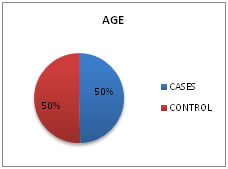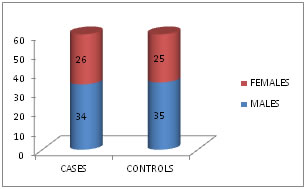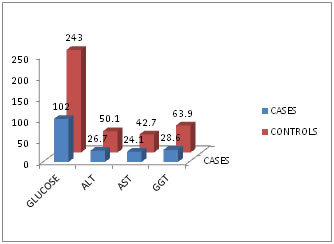Official Journals By StatPerson Publication
|
Table of Content - Volume 5 Issue 3 - March 2018
Study of serum GGT and ALT levels as markers of oxidative stress in type 2 diabetes mellitus
Shravan Kumar1, Bhuvanendranath H2*
1Senior Resident, Department of Biochemistry, ESIC Hospital, Indore, Madhya Pradesh, INDIA. 2Assistant Professor, Department of Biochemistry, Sree Mookambika Institute of Medical Sciences, Kulasekharam, INDIA. Email: bhunu.heroor@gmail.com
Abstract Context: The role of oxidant stress in the causation of Diabetes mellitus is increasingly being recognized. Very recently it has also been shown that hypoglutathionaemia and increased oxidative stress appear to be early biochemical aberrations in Diabetes and through protein alterations, oxidative stress and redox modifications may contribute to pathogenesis of diabetic microangiopathy. Increased erythrocyte glutathionylatedHb (HbSSG) levels with decreased glutathione (GSH) was shown to be associated with Diabetes Mellitus indicating that the increased oxidative stress may be one of the implicating factors in pathogenesis of Type 2 Diabetes Mellitus. Objective: To estimate serum GGT and ALT levels in type 2 diabetes mellitus and to correlate it with normal population Material and Methods: This study was conducted in ESIC hospital. Thirty five patients reporting to the OPD diagnosed for type 2 diabetes between the age group of 50-60 years of both sex (cases) and thirty five healthy age and sex matched individuals (control) were included in the study. Under aseptic precaution blood samples were collected and centrifuged to get serum and were used for estimation. Data were analysed by student t test and values expressed as the mean ± SD and Pearson’s correlation coefficient is calculated to evaluate the relationship between 2 groups. Results: The result of the present study showed that serum GGT and ALT levels are raised in type 2 diabetes but GGT levels was significantly raised(p<0.01) in type 2 diabetes. Conclusion: Oxidative stress plays a major role in pathogenesis of Diabetes mellitus and in our study it is found that serum GGT is more reliable marker of oxidative stress than ALT. Hence serum GGT can be used for assessment and monitoring the complications of diabetes. Key Words: GGT, ALT, type 2 Diabetes mellitus, oxidative stress.
Diabetes Mellitus is a major medical problem throughout the world. Diabetes causes an array of long-term systemic complications that have considerable impact on the patient as well as society, as the disease typically affects individuals in their most productive years. India, the world’s second most populous country, now has more number of people with Type 2 Diabetes than any other nation. Calling India the diabetes capital of the world, the International Journal of Diabetes in Developing Countries says that there is an alarming rise in cases1. The WHO estimated that there were 31.7 million persons with Diabetes in India in year 2000 and this number is likely to rise by 71.4 million in 2030.2 The role of oxidant stress in the causation of Diabetes mellitus is increasingly being recognized.3 Very recently it has also been shown that hypoglutathionaemia and increased oxidative stress appear to be early biochemical aberrations in Diabetes and through protein alterations, oxidative stress and redox modifications may contribute to pathogenesis of diabetic microangiopathy. Increased erythrocyte glutathionylated Hb (HbSSG) levels with decreased glutathione (GSH) was shown to be associated with Diabetes Mellitus indicating that the increased oxidative stress may be one of the implicating factors in pathogenesis of Type 2 Diabetes Mellitus.4 Liver, a vital organ in metabolism, plays an important role in maintaining glucose homeostasis.5 Markers of liver injury, such as alanine aminotransferase (ALT) and γ-glutamyltransferase (GGT), shown to be good surrogate measures of non-alcoholic fatty liver disease (NAFLD), the most common chronic liver conditions characterized by excess deposition of fat in the liver, and associated with hepatic insulin resistance2 and type 2 diabetes (T2D) risk.6 Kerner et al. demonstrated, in a general population, an association between increased plasma levels of CRP and elevated serum ALT in subjects with MetS, and proposed that hepatic inflammation related to NAFLD might be involved in the systemic inflammation associated with MetS7. ALT, found predominately in the liver, has been considered the most specific marker for liver injury, 8 while GGT is present on the surface of most cell types and highly active in liver, kidney, and pancreas.9 GGT is responsible for catabolism of extracellular glutathione and may be linked to oxidative stress 10 and chronic inflammation, 11 which are also important pathways for T2D development. Most previous studies examining the association between liver enzymes and incidence of type 2 diabetes have included only ALT or GGT. A limited number of prospective studies have examined the associations of AST, ALT, and GGT with risk of type 2 diabetes; however, the results were inconsistent12,13,14. Since most of the studies were conducted on western population, the purpose of this study is to estimate serum GGT and ALT levels as a marker of oxidative stress in type 2 diabetes mellitus and to correlate it with normal Indian population.
MATERIALS AND METHODS Source of data: This study was conducted in ESIC Hospital. Sixty patients reporting to the OPD diagnosed for type 2 diabetes between the age group of 35-55 years of both sex (cases) and sixty healthy age and sex matched individuals (control) were included in the study. Age and sex matched voluntary blood donors attending the blood bank of this hospital forms the control group. Exclusion Criteria: Chronic liver and kidney disease, alcoholics, on drugs like heparin, phenytoin, valproic acid, ischemic heart diseases, peripheral vascular diseases. Under aseptic precautions blood samples were collected and centrifuged to get serum and were used for estimation. The Serum is separated by centrifugation at 3000 RPM for 10 minutes. Then serum Glucose, ALT and GGT are analyzed by COBAS INTEGRA 400. Glucose is estimated by enzymatic reference method with Hexokinase. The concentration of NADPH formed is directly proportional to glucose concentration. It is determined by measuring the increase in Absorbance at 340 nm. Alanine Aminotransferase (ALT) is calculated according to International Federation of Clinical Chemistry (IFCC) method using Pyridoxal -5-phosphate. Rate of NADH oxidation is directly proportional to catalytic activity of ALT, it is determined by measuring the decrease in absorbance at 340 nm. Aspartate Aminotransferase (AST) is calculated according to International Federation of Clinical Chemistry (IFCC) method using Pyridoxal -5-phosphate. Rate of NADH oxidation is directly proportional to catalytic activity of AST activity, it is determined by measuring the decrease in absorbance at 340 nm. Gamma Glutamyl Transferase (GGT) is estimated by using L- gamma -glutamyl-3-carboxy-4-nitroanilide as the donor substrate and glycylglycine as the acceptor substrate. Using these two substrates, the following reaction is catalyzed by the presence of GGT: L- gamma-Glutamyl-3carboxy-4-nitroanilide + glycylglycine GGT > L- gamma-Glutamyl-glycylglycine + 5-amino-2-nitrobenzoate The rate of liberation of yellow colored 5-amino-2-nitrobenzoate is directly proportional to the GGT activity in the sample and is quantitated by measuring the increase in absorbance (at 409 nm). Data analysed by student t test and values expressed as the mean ± SD and Pearson’s correlation coefficient is calculated to evaluate the relationship between2 groups. The minimum level of significance is set at p<0.05 OBSERVATION AND RESULTS Mean age of the subjects in controls are 46.42 yrs with a standard deviation of 3.06 years, in cases are 47.04 years with a standard deviation of 2.27 years. P = 0.49 (there is no significant difference in age between the groups)
Figure 1:
In this study, the total number of men was 34 and women 26 in cases, and 35 men and 25 women in controls. This is not statistically significant (p=0.5)
Figure 2:
The results of ALT, AST and GGT levels are increased significantly (p<0.01) in type 2 diabetic patients as compared to normal controls (Table-1)
Table 1:
Figure 3:
Glucose, ALT, AST and GGT in normal individuals and Type 2 Diabetic patients. Values are expressed as Mean ± Standard Deviation. N=25 in each group.
DISCUSSION Type 2 diabetes comprises about 80% cases of diabetes mellitus. Diabetes is a leading cause of morbidity and mortality world over. It is estimated that approximately 1% of the population suffers from diabetes mellitus. The incidence is rising in the developed countries of the world at the rate of about 10% per year, especially of type 2diabetes, due to rising incidence of obesity and reduced activity level. Diabetes mellitus is expected to continue as a major health problem owing to its serious complications, especially end stage renal disease, IHD, gangrene of the lower extremities, and blindness in the adults 15 This was evidenced in the previous studies and in our present study, in which we observed a significant increase in the level of ALT, AST and GGT. The major metabolic defect in type 2 diabetes is either a delayed insulin secretion relative to glucose load (impaired insulin secretion), or the peripheral tissues are unable to respond to insulin (insulin resistance). Type 2 diabetes is a heterogenous disorder with a more complex etiology and is far more common than type 1, but much less is known about its pathogenesis. In type 2 diabetes, there is non-enzymatic glycosylation of proteins which produces advanced glycosylated end products that gets deposited in the basement membranes of blood vessels and other structures inducing free radical damage.
CONCLUSION Oxidative stress plays a major role in Type 2 Diabetes Mellitus. In the present study, a significant increase in the level of liver enzymes; ALT, AST and GGT are observed in type 2 diabetic patients when compared to the normal patients. Hence, there is an association between the level of liver enzymes, ALT, AST and GGT in type 2 diabetic patients. But serum GGT levels are significantly raised than ALT. Hence it is more reliable marker of oxidative stress in Type 2 Diabetes Mellitus and being a routine parameter, can be used to monitor the complications of Diabetes Mellitus.
REFERENCES
|
 Home
Home



